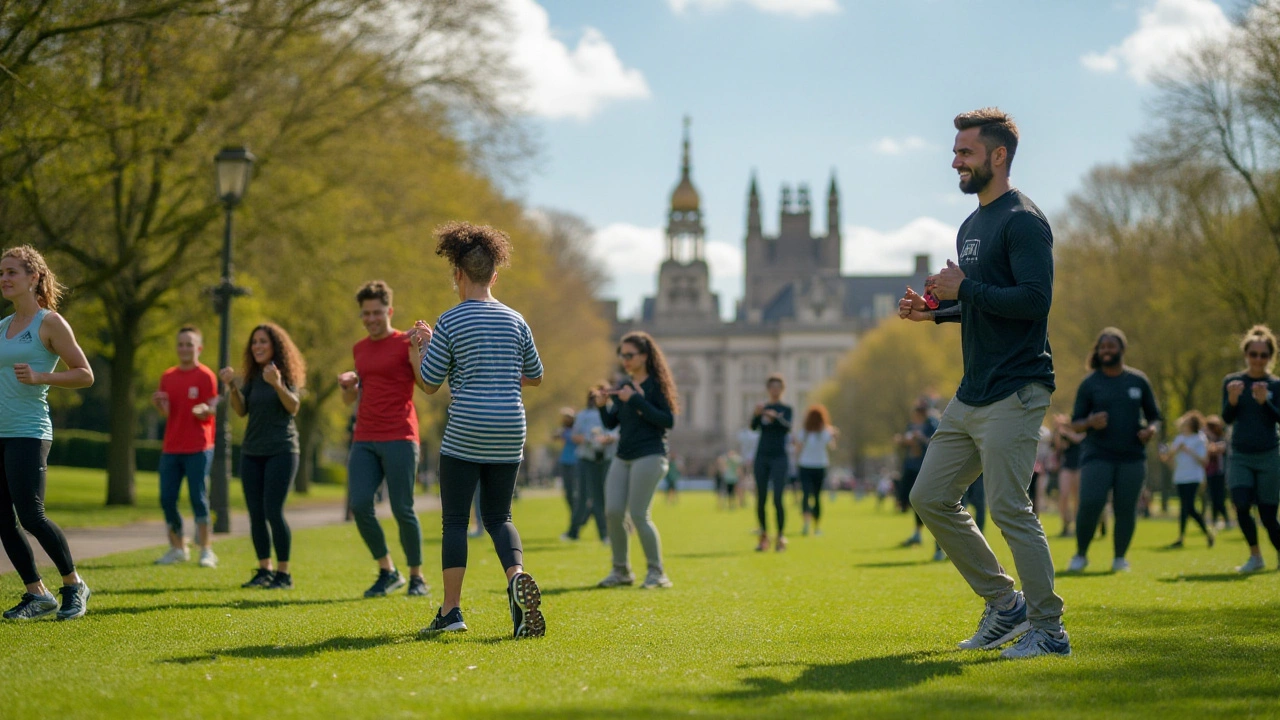
Embarking on a workout journey can feel both exciting and daunting. For those new to exercise, the myriad of information available can easily become overwhelming. Yet, the secret to success lies in simplicity and consistency.
Don't fret over perfection from the start; instead, focus on laying a foundation that feels right for you. A beginner need not leap into complex routines; basic exercises that suit individual capabilities make for a great start. This article sheds light on crafting a fitness plan tailored for novices, guiding you through each step with practical advice and insights.
Embarking on your fitness journey begins with grasping the fundamental elements of a beginner workout plan. Understanding the basics is the cornerstone for anyone eager to start a sustainable exercise routine. To begin, it's crucial to acknowledge that the body needs time to adapt to new activities. The body is a complex, resilient system, but like any machine, it functions optimally when eased into new routines gradually. This is where a foundational approach comes into play, building strength, endurance, and flexibility through tried-and-true methodologies. For beginners, the key is to ensure that exercises are not only effective but also approachable and satisfying.
Before diving into a workout, warming up should always take precedence. This isn't just a ritual; it's a necessity that boosts your performance while minimizing the risk of injury. Warming up increases body temperature and blood flow to your muscles, which can enhance both mental and physical performance during your workout. Activities like light cardio or dynamic stretching can effectively prepare your muscles for the more intense workout ahead.
Dr. Jordan Metzl, a sports medicine physician, once noted, "A good warm-up is like turning on all your car engines before starting a race. If you start the race without turning on the engine, disaster happens."
Exercises generally fall into several categories, each serving different purposes and engaging various muscle groups. Strength training, for instance, focuses on building muscle strength and size, often involving weights or resistance bands. Cardiovascular exercises are all about building stamina and burning calories, and can include activities like running or cycling. Meanwhile, flexibility exercises, like yoga or Pilates, enhance your range of motion and improve balance. It's best for beginners to incorporate a mix of these exercises to ensure a well-rounded approach to fitness. This not only helps in achieving desired fitness goals, but it also keeps the routine interesting.
As a newcomer, it's paramount to assess your current fitness level, which can guide you in selecting appropriate activities and setting realistic goals. Many beginners often make the mistake of overestimating their capabilities, which can lead to frustration or injury. Evaluating where you stand in terms of strength, flexibility, and endurance will help you tailor a plan that suits you. You can start with self-assessments or schedule a session with a fitness professional to gain insights into your current state and how you can safely progress.
| Exercise Type | Benefits |
|---|---|
| Strength Training | Builds muscle strength and boosts metabolism |
| Cardiovascular | Increases heart health and burns calories |
| Flexibility | Improves range of motion and reduces injury risk |
Understanding these basic principles sets the stage for crafting an effective workout plan and ensures you can progress safely and confidently. The more knowledge you have about the core elements of exercise, the better equipped you are to maximize your time and effort in the gym or at home. So, embrace the learning curve, and let the basics guide you as you embark on this exciting path to wellness.
When you set out to start an exercise routine, it's vital to have a clear understanding of what you hope to achieve. Many beginners mistakenly aim for ambitious targets without considering their current fitness levels, leading to frustration and burnout. Instead, setting realistic goals ensures that progress is both achievable and sustainable. Begin by assessing your current physical state. Consider factors such as endurance, strength, and any limitations or previous injuries. This self-awareness forms the bedrock on which meaningful goals can be established.
Begin by defining what success looks like to you. Is it the ability to run a mile without stopping, lifting a certain weight, or simply feeling more energetic? Each fitness journey is as unique as the individual undertaking it. Write down your goals; research shows that people who commit their objectives to paper are more likely to succeed. Dr. Gail Matthews, a psychology professor, discovered through her studies that individuals who write down their goals have a significantly higher chance of achieving them compared to those who don't.
"Goals that are smart — specific, measurable, achievable, relevant, and time-bound — are crucial for maintaining motivation," says Matthews.
Integrate these principles into your planning. Specificity is vital — rather than aiming to "get fit," strive to walk for 30 minutes, five days a week. Measurable targets give you something concrete to track. As you progress, regularly review and adjust your goals to maintain a challenging, yet attainable path. For instance, if you realize you're consistently walking more than 30 minutes easily, increment your duration or pace. But remember, these changes should not come at the expense of your health. Listening to your body is critical. Advancing too quickly can lead to injuries which might derail your progress altogether.
Statistics suggest that about 67% of people who begin workouts without clear goals abandon them within six months. To combat this, create a timeline for your goals that allows for flexibility. Life is unpredictable; obstacles may arise, but having a flexible timeline enables adjustments without derailing progress. Celebrate small victories along the way. Small rewards for milestones increase motivation and make the journey enjoyable. Whether it's treating yourself to a new workout accessory or a relaxing day off, acknowledging achievements fuels enthusiasm.
Incorporating realism into your fitness regime does not diminish ambition. On the contrary, it aligns your desires with your lifestyle, providing a solid platform from which to soar. As you embark on this path, keep in mind the importance of patience and persistence. Success in fitness is a marathon, not a sprint. With realistic goals, the beginner workout plan transforms from a simple aspiration into a structured roadmap leading to lifelong health benefits.

When it comes to starting a fitness journey, the maze of workout options can easily bewilder beginners. The key to choosing the right exercises is to understand your body's current capabilities and the type of workout that aligns with your individual goals. There's no one-size-fits-all in fitness, and that's what makes your workout experience uniquely yours. To commence, begin with exercises that emphasize fundamental movements such as squats, lunges, push-ups, and planks. These exercises form a strong foundation, engaging multiple muscle groups while enhancing overall body strength, balance, and endurance. Selecting exercises that you enjoy can significantly boost your enthusiasm and commitment, laying a path toward a sustainable routine.
For those setting out on this journey, it's crucial to focus on a balanced mix of cardiovascular, strength, and flexibility training. Cardiovascular workouts, like brisk walking, jogging, or cycling, are excellent for improving heart health and endurance. Adding in strength training exercises using your body weight or light dumbbells can increase muscle strength and aid metabolism. Flexibility exercises, such as yoga or simple stretching routines, help maintain a range of motion in the joints and prevent injuries. Distinguished fitness expert Jillian Michaels once advised,
"Variety is key to maintaining interest in your workouts. Picking exercises you find enjoyable ensures you’ll stick to your routine over the long term."Following this wisdom, try integrating different types of exercises weekly to keep your routine fresh and invigorating.
If you're still unsure about what specific workouts to incorporate, consider your unique set of goals first. Are you aiming to improve stamina, build muscle, or lose weight? Each of these objectives might necessitate a different focus. For improved stamina, engaging in interval training or circuit exercises can be greatly beneficial. Those who aim to build muscle might consider investing time in resistance exercises like squats with weights or pull-ups. Beginners should start slow and progressively increase the intensity to avoid exhaustion or injury.
Bear in mind that safety is paramount. When experimenting with new workouts, pay attention to proper form and technique. Engaging with online demonstration videos or consulting a personal trainer can help correct posture and avoid common mistakes. Moreover, maintaining an exercise log can help track your workouts, monitor progress, and identify areas that need attention. It's also wise to listen to your body and give yourself grace by taking rests when needed, particularly when pushing beyond familiar limits.
Incorporate the notion of 'mind over body.' As you familiarize yourself with different exercises, try portraying a positive mindset. Visualize meeting your fitness goals and recognize that each step you take leads you closer. Enjoy the process, remember to breathe, and celebrate small achievements. By choosing the right exercises smartly, you're sowing the seeds for a healthier, robust future.
Creating a workout routine, especially for a beginner, requires careful planning and self-awareness. It sets the stage for everything that is to come in your fitness journey. Being deliberate about the foundations you create now will pay dividends as you progress. For beginners, there’s no need to jump into an intense regimen right away. Instead, aim for a balanced approach that incorporates different facets of fitness, yet remains flexible enough to adjust as needed. The primary goal is to introduce your body to regular activity that increases gradually in intensity. The consistency cultivated at this stage is what counts the most.
Start with identifying days that you can commit to working out. It doesn't have to be every day—often, three to four days a week is quite adequate for beginners. Next, it’s wise to mix up the types of exercises you plan to do. Variety is key here. Resistance training, cardio exercises, and flexibility workouts all have their place in a well-rounded program. It's essential to include a warm-up and cool-down in every session, which helps prevent injuries and prepares your body for the next workout cycle. Most beginners find success with sessions that last between 30–45 minutes.
Many fitness experts recommend that beginners start with a focus on form rather than weight or intensity. For example, bodyweight exercises such as squats, push-ups, and planks are excellent for mastering proper execution without added risk. Once comfortable, gradually introduce dumbbells or resistance bands. Cardiovascular exercises like walking, jogging, or cycling for about 15–20 minutes can significantly improve stamina. It's important to note how much rest is just as important as the activity itself. Allowing muscles time to repair not only grows strength but also reduces fatigue and burnout.
"The best routines are the ones that you can stick to," says James Clear, author of Atomic Habits. "Making small improvements each day can lead to significant transformations over time, especially for those new to fitness."
If you decide to track progress, it might be encouraging to keep a fitness journal or use an app. Recording workouts, tracking meals, and noting personal achievements keep you accountable and provide a tangible record of your development. As you evolve, update your routine to match your growing capabilities and interests. Remember, patience is key, and comparing your journey to others’ can derail motivation. Your primary focus should be on building sustainable habits that enhance your lifestyle. Sticking with these elements will soon see you reaping the rewards of a healthier, fitter self.

In the world of exercise, maintaining momentum is one of the greatest challenges, not just for beginners but also for seasoned athletes. Understanding what drives you can transform your beginner workout plan from a short-lived interest into a lifelong pursuit of fitness. The first key to staying motivated is setting personal intentions. Ask yourself why you want to get fit. Is it to improve your mental health, gain more energy, or perhaps to achieve a specific physical goal? Your ‘why’ serves as a compass to guide you through those days when motivation wanes.
Having short-term and long-term goals can create a roadmap for your journey. Whipping these goals into reality starts with setting daily and weekly challenges that lead to them. Sometimes motivation is stoked by small victories—whether it's running for five minutes longer or lifting slightly heavier weights. Try to associate these wins with positive emotions by celebrating them. These celebrations don't have to be grand; even saying to yourself, "I did this!" elicits a sense of accomplishment that motivates you to continue.
Another powerful motivator is accountability. This can be through tracking your progress in a journal or sharing your journey with a friend. Whether it’s talking about what you've achieved or showing a physical journal entry, accountability partners can massively help in preserving adherence to your routine. Fitness technology, like workout apps or wearable devices, helps by tracking steps, calories burned, and other metrics which can serve as an ongoing log of your progress. This collection of data provides a clearer view of how you’re inching towards your pivotal goals.
"Exercise not only changes your body, it changes your mind, your attitude and your mood," as famously quoted by Fitness Coach Joe Dowdell, reminds us of the overarching benefits of staying on track.
Social engagement is a crucial yet often underestimated factor. Whether it's joining a group class, being part of an online community or simply working out with a buddy, the sense of belonging keeps motivation burning brightly. Humans naturally seek connections, and this sense of camaraderie often propels people further than they would go alone. Plus, sharing experiences—whether it’s hitting new milestones or overcoming hurdles—adds a layer of enjoyment to the fitness experience.
Finally, remember to inject variety into your routine. Repeating the same exercises day can lead to plateauing and boredom. Switch it up by trying a new fitness class, dabble in a different sport, or even explore outdoor activities. By keeping things fresh, you nourish both body and mind, making it easier to adhere to your start exercise routine. It also aids in the body’s overall conditioning by working on muscles that aren’t normally engaged in your usual exercises. Keeping the spark alive is about continuously discovering what motivates and excites you throughout your fitness journey.